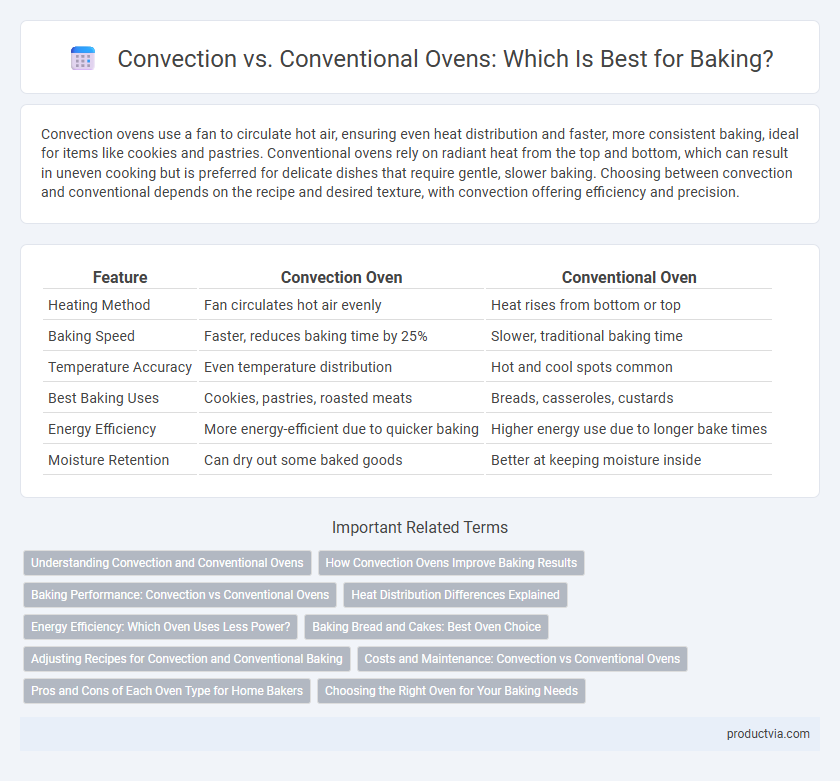Convection ovens use a fan to circulate hot air, ensuring even heat distribution and faster, more consistent baking, ideal for items like cookies and pastries. Conventional ovens rely on radiant heat from the top and bottom, which can result in uneven cooking but is preferred for delicate dishes that require gentle, slower baking. Choosing between convection and conventional depends on the recipe and desired texture, with convection offering efficiency and precision.
Table of Comparison
| Feature | Convection Oven | Conventional Oven |
|---|---|---|
| Heating Method | Fan circulates hot air evenly | Heat rises from bottom or top |
| Baking Speed | Faster, reduces baking time by 25% | Slower, traditional baking time |
| Temperature Accuracy | Even temperature distribution | Hot and cool spots common |
| Best Baking Uses | Cookies, pastries, roasted meats | Breads, casseroles, custards |
| Energy Efficiency | More energy-efficient due to quicker baking | Higher energy use due to longer bake times |
| Moisture Retention | Can dry out some baked goods | Better at keeping moisture inside |
Understanding Convection and Conventional Ovens
Convection ovens use a fan to circulate hot air evenly around the food, resulting in faster, more uniform baking and improved browning compared to conventional ovens, which rely on radiant heat from the top and bottom elements. Conventional ovens often create hot spots and require longer cooking times, making them ideal for recipes that benefit from slow, gentle heat. Understanding these differences helps bakers choose the right oven type based on the desired texture, crust, and cooking speed.
How Convection Ovens Improve Baking Results
Convection ovens enhance baking results by circulating hot air evenly around the food, ensuring uniform cooking and reducing hot spots common in conventional ovens. This airflow accelerates heat transfer, resulting in faster baking times and improved browning, particularly for pastries and roasted dishes. The consistent temperature and moisture retention in convection ovens produce crispier crusts and more evenly baked goods compared to conventional baking methods.
Baking Performance: Convection vs Conventional Ovens
Convection ovens enhance baking performance by circulating hot air evenly around food, resulting in faster, more uniform cooking and better browning compared to conventional ovens. Conventional ovens rely on radiant heat from the top and bottom elements, which can create hot spots and uneven baking, especially for multi-rack cooking. For consistent results in baking bread, pastries, and casseroles, convection ovens provide superior temperature accuracy and moisture retention.
Heat Distribution Differences Explained
Convection ovens use a fan and exhaust system to circulate hot air evenly, resulting in consistent heat distribution and faster baking times. Conventional ovens rely on natural heat transfer from the heating elements, causing hot spots and uneven cooking. This makes convection ovens ideal for baking multiple trays or delicate items requiring uniform temperature.
Energy Efficiency: Which Oven Uses Less Power?
Convection ovens use a fan to circulate hot air, resulting in faster and more even cooking, which significantly reduces energy consumption compared to conventional ovens that rely on radiant heat. Studies indicate convection ovens can cut baking time by 25-30%, translating into lower electricity usage and cost savings. Choosing a convection oven optimizes energy efficiency for baking tasks by maintaining consistent temperatures with less heat loss.
Baking Bread and Cakes: Best Oven Choice
Convection ovens circulate hot air evenly, resulting in faster, more uniform baking, which is ideal for bread with crispy crusts and evenly risen cakes. Conventional ovens rely on radiant heat from elements, providing gentler heat that is preferred for delicate cakes requiring gradual, consistent rising and moisture retention. For baking bread, convection ovens enhance crust texture, while conventional ovens offer better control for tender cakes, making the best choice dependent on the specific baked good's texture requirements.
Adjusting Recipes for Convection and Conventional Baking
Adjusting recipes for convection baking requires lowering the oven temperature by 25degF (about 15degC) and reducing cooking time by 25% to prevent overbaking due to the fan's hot air circulation. Conventional baking maintains more stable, radiant heat, which may necessitate following traditional recipe times and temperatures. Understanding these differences ensures optimal texture and doneness, especially for delicate baked goods like cakes and pastries.
Costs and Maintenance: Convection vs Conventional Ovens
Convection ovens generally have higher initial costs due to advanced fan systems that ensure even heat distribution, while conventional ovens are more affordable upfront but may require longer cooking times. Maintenance for convection ovens can be more expensive because the fan and motor need regular servicing, whereas conventional ovens have simpler components resulting in lower repair costs. Energy efficiency in convection ovens often reduces long-term utility expenses, offsetting their higher purchase and upkeep costs compared to conventional models.
Pros and Cons of Each Oven Type for Home Bakers
Convection ovens use a fan to circulate hot air, providing even heat distribution that results in faster, more consistent baking and better browning, ideal for multi-rack cooking and pastries. Conventional ovens rely on radiant heat from elements, offering a more traditional baking environment preferred for delicate items like custards and bread with a crisp crust but often require longer cooking times and frequent rotation for even results. Home bakers benefit from convection ovens for efficiency and uniformity, while conventional ovens excel in gentle heat application, making oven choice dependent on specific baking needs.
Choosing the Right Oven for Your Baking Needs
Convection ovens use a fan to circulate hot air evenly, reducing baking times and producing consistent browning, making them ideal for cookies, pastries, and roasting. Conventional ovens rely on radiant heat from the top and bottom, providing a more gradual and traditional baking process suitable for bread and custards that benefit from slower, gentler heat. Selecting the right oven depends on your baking style and recipes, with convection ovens offering efficiency and uniform results, while conventional ovens preserve classic textures and flavors.
Convection vs Conventional for baking Infographic

 productvia.com
productvia.com